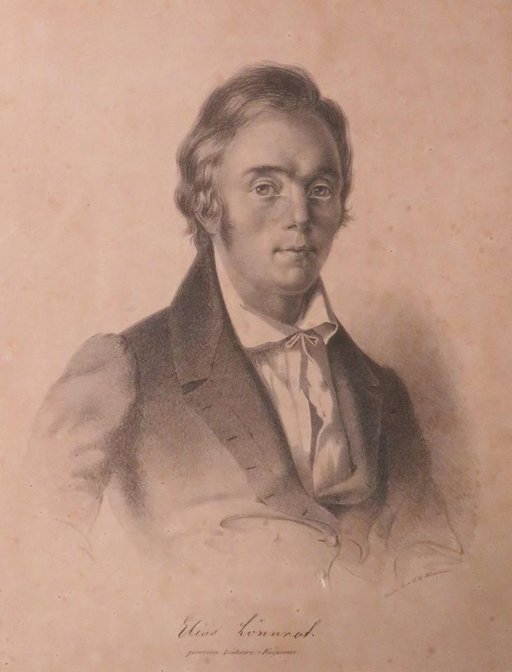Elias Lönnrot, 1802-1884
Elias Lönnrot was a philologist and a collector of Finnic-Karelian traditional poetry, which he compiled in order to create the Kalevala.
Elias Lönnrot's role in the Kalevala

Elias Lönnrot is most well known for his role in creating the Kalevala, a national epic poem based on Finnish mythology and oral folk poetry from Karelia - although the term 'Kalevala' can also refer to Finnish or Karelian oral tradition and mythology more widely.
Elias Lönnrot was from Sammatti in southern Finland, and he recognised the importance of developing written Finnish. At that time, the Finnish language existed as a variety of different regional dialects rather than as an established standard. Karelian poetry had begun to die out during the eighteenth century, and Lönnrot, who had written his undergraduate thesis on Väinämöinen, a hero and the main character of the Kalevala, wanted to preserve folk poetry.
Lönnrot went to Karelia to collect the verses and poems which made up the Old Kalevala, published in 1835. He made five trips prior to 1834, and he then made 11 trips up until 1848, which contributed towards the later published versions of the epic (see our article on the Different Meanings of the Kalevala for a list of five different versions originally printed).
Lönnrot's expeditions to Karelia not only formed the basis of the Kalevala but they also became a key foundation of the Finnish Literature Society (Suomalaisen Kirjallisuuden Seura), which was first formed in 1831. The Society was an independent organisation with the aim of promoting ‘the advancement of a diverse Finnish Culture.’ (It still exists today). It sought to change the status of the Finnish language from being a predominantly oral one to a more widely used language with a recognised status. It published the Kalevala, and actively presented Lönnrot as an exemplary figure – he later became president of the Society in the 1950s.
Language and politics
Finland was part of the Swedish empire from the twelfth century until 1809 when it became an autonomous Grand Duchy under Russia from 1809 until 1917. The Kalevala is a symbol of Finland’s struggle for independence in the nineteenth century and continues to unite Finns. At the same time, Kalevala is closely related to the identity and culture of the region of Karelia, parts of which are now in Russia, and debates continue to flourish about its content and meaning in contemporary society. Lönnrot can therefore be seen as rather a controversial figure.
Elias Lönnrot was considered a member of the Fennoman movement, which was led by a group of intellectuals who considered ‘cultural homogeneity to be the cornerstone of the nation’. Their aim was to replace Swedish, the ‘traditional language of the gentry’, with Finnish as the language of ‘cultural life and administration’. Many argued that a nation must possess ‘a distinctive cultural identity founded on the language and oral literature of the ordinary, unlettered people’. The opposition movement was the Svecomans, a pro-Swedish nationalist party that were against the Finnish language becoming an official language on an equal footing with Swedish. This party arose at the end of the nineteenth century as a reaction to the increased use of Finnish.
Lönnrot was among the first to put forward the idea of a common ancestry between Karelians and Finns, which was a key principle to Fennomania, particularly in the 1830s. Johan Vilhelm Snellman, a Fennoman philosopher, author and politician, also sought to show the Grand Duchy that Finns had their own culture separate from the Russian state. Snellman was a key figure in the passing of a language decree which gave Finnish an equal status to that of Swedish within the government in 1863. Promoting the Finnish language was a pillar for their own beliefs and culture, and a key foundation of the Finnish independence movement at the time.
Further reading:
- Elias Lönnrot, Old Kalevala 1835, trans. by Kaarina Brooks (Wisteria Publications, 2020).
- Elias Lönnrot, Kalevala, trans. by Kaarina Brooks (Wisteria Publications, 2021).
- Ilkka Liikanen (1988) 'Light to our people: Educational organization and the mobilization of fennomania in the 1870s', Scandinavian Journal of History, 13,4 (1988) pp. 421-438.